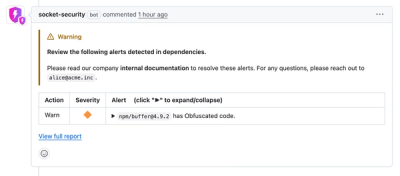
Security News
Crates.io Users Targeted by Phishing Emails
The Rust Security Response WG is warning of phishing emails from rustfoundation.dev targeting crates.io users.
django-user-agents-last
Advanced tools
A django package that allows easy identification of visitors' browser, operating system and device information (mobile phone, tablet or has touch capabilities).
Fork: https://github.com/selwin/django-user_agents
A django package that allows easy identification of visitor's browser, OS and device information,
including whether the visitor uses a mobile phone, tablet or a touch capable device. Under the hood,
it uses user-agents <https://github.com/selwin/python-user-agents>_.
Install django-user-agents, you'll have to make sure that user-agents_ is installed first::
pip install pyyaml ua-parser user-agents pip install django-user-agents
Configure settings.py:
.. code-block:: python
INSTALLED_APPS = (
# Other apps...
'django_user_agents',
)
# Cache backend is optional, but recommended to speed up user agent parsing
CACHES = {
'default': {
'BACKEND': 'django.core.cache.backends.memcached.MemcachedCache',
'LOCATION': '127.0.0.1:11211',
}
}
# Name of cache backend to cache user agents. If it not specified default
# cache alias will be used. Set to `None` to disable caching.
USER_AGENTS_CACHE = 'default'
Add UserAgentMiddleware in settings.py:
.. code-block:: python
MIDDLEWARE_CLASSES = (
# other middlewares...
'django_user_agents.middleware.UserAgentMiddleware',
)
A user_agent attribute will now be added to request, which you can use
in views.py:
.. code-block:: python
def my_view(request):
# Let's assume that the visitor uses an iPhone...
request.user_agent.is_mobile # returns True
request.user_agent.is_tablet # returns False
request.user_agent.is_touch_capable # returns True
request.user_agent.is_pc # returns False
request.user_agent.is_bot # returns False
# Accessing user agent's browser attributes
request.user_agent.browser # returns Browser(family=u'Mobile Safari', version=(5, 1), version_string='5.1')
request.user_agent.browser.family # returns 'Mobile Safari'
request.user_agent.browser.version # returns (5, 1)
request.user_agent.browser.version_string # returns '5.1'
# Operating System properties
request.user_agent.os # returns OperatingSystem(family=u'iOS', version=(5, 1), version_string='5.1')
request.user_agent.os.family # returns 'iOS'
request.user_agent.os.version # returns (5, 1)
request.user_agent.os.version_string # returns '5.1'
# Device properties
request.user_agent.device # returns Device(family='iPhone')
request.user_agent.device.family # returns 'iPhone'
If you have django.core.context_processors.request enabled, user_agent
will also be available in template through request::
{% if request.user_agent.is_mobile %}
Do stuff here...
{% endif %}
django-user_agents comes with get_user_agent which takes a single
request argument and returns a UserAgent instance. Example usage:
.. code-block:: python
from django_user_agents.utils import get_user_agent
def my_view(request):
user_agent = get_user_agent(request)
if user_agent.is_mobile:
# Do stuff here...
elif user_agent.is_tablet:
# Do other stuff...
django-user_agents comes with a few template filters:
is_mobileis_tabletis_touch_capableis_pcis_botYou can use all of these like any other django template filters::
{% load user_agents %}
{% if request|is_mobile %}
Mobile device stuff...
{% endif %}
{% if request|is_tablet %}
Tablet stuff...
{% endif %}
{% if request|is_pc %}
PC stuff...
{% endif %}
{% if request|is_touch_capable %}
Touch capable device stuff...
{% endif %}
{% if request|is_bot %}
Bot stuff...
{% endif %}
You can find out more about user agent attributes at here <https://github.com/selwin/python-user-agents>_.
.. code-block:: console
`which django-admin.py` test django_user_agents --settings=django_user_agents.tests.settings --pythonpath=.
get_user_agent function in utils.pyKeyError exception in the case of empty HTTP_USER_AGENTFAQs
A django package that allows easy identification of visitors' browser, operating system and device information (mobile phone, tablet or has touch capabilities).
We found that django-user-agents-last demonstrated a healthy version release cadence and project activity because the last version was released less than a year ago. It has 1 open source maintainer collaborating on the project.
Did you know?

Socket for GitHub automatically highlights issues in each pull request and monitors the health of all your open source dependencies. Discover the contents of your packages and block harmful activity before you install or update your dependencies.

Security News
The Rust Security Response WG is warning of phishing emails from rustfoundation.dev targeting crates.io users.

Product
Socket now lets you customize pull request alert headers, helping security teams share clear guidance right in PRs to speed reviews and reduce back-and-forth.

Product
Socket's Rust support is moving to Beta: all users can scan Cargo projects and generate SBOMs, including Cargo.toml-only crates, with Rust-aware supply chain checks.